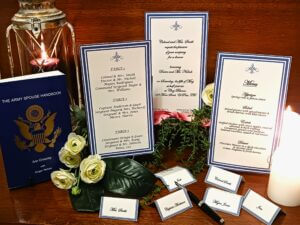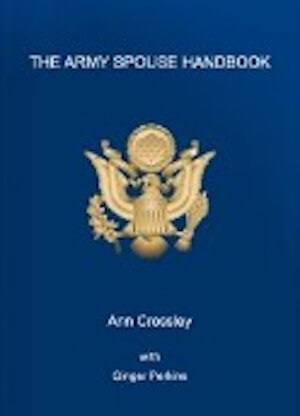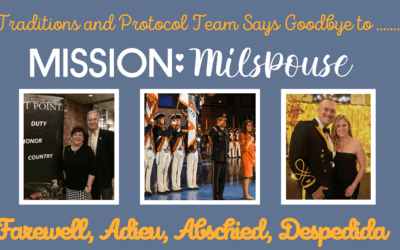We offer you this blog to outline examples of new guidance on receiving lines, invitations, and place cards for modern inclusivity.
British history remembers an anecdotal dinner party hosted by Queen Victoria for visiting foreign dignitaries. The story recalls the guest of honor, unfamiliar with finger bowls, drinking his as if it were a cup of soup at the end of a meal. With her guests aghast at the serious faux pas, the always gracious Queen, also picked up her finger bowl and enjoyed it along with her guest!
Our military and civilian society is always changing, and our M:M protocol and traditions team are here to help you keep up. No matter the changes, the number one rule is to make your guests feel comfortable just as Queen Victoria did so long ago.
Receiving and Reception Lines
Typically featured at formal events and ceremonies, receiving lines allow attendees to greet hosts and honored guests. The receiving line should be kept small. The host(s) and guest(s) of honor are the principals in the receiving line and are honored by standing on the red carpet. The reception line is made up of guests so they can greet the principals in the receiving line.
“Receiving” Line
An aide-de-camp or adjutant should stand at the head of the line, when possible, to announce guests. It is acceptable for a person of any gender to stand at the end of the receiving line.
While deferring to the preferences of the host(s), below are some suggested arrangements for receiving lines for official functions regardless of gender when there is a guest of honor.
- Host, spouse of host, guest of honor, spouse of guest of honor.
- Host, guest of honor, spouse of host, spouse of the guest of honor.
- Host, guest of honor, spouse of the guest of honor, spouse of host.
For traditional unit receptions at a ball without a guest of honor, the receiving line may look like this:
Commander, commander’s spouse, senior NCO, senior NCO spouse.
“Reception” Line
Remembering that all attendees should proceed through the reception line, the unit member or primary invitee who received the invitation should precede their guest regardless of gender, rank, or title.
This allows them to introduce their guests to the principals in the receiving line.
Addressing Invitations
When addressing invitations and other correspondence (other than emails and evites), the primary invitee should be listed first, regardless of rank, title, or gender.
When you’re unsure if the couple or individual prefers Mr., Mrs., Ms., wife, husband, spouse, or partner, it’s best to ask their preference.
Guests invited as a couple could be listed in the traditional way (e.g., Sergeant and Mr. Allen); dual-military couples who share the same last name and rank are addressed in the plural (e.g., Majors Jones).
Place Cards
To correctly address place cards on the table, rank should be spelled out. The front side with the crest should read “Colonel Simpson” or “Mrs. Jones,” (optional to also use first name initial) and the back would show their go-by name.
The highest-ranking service member’s place card often reads the same front and back: “Colonel Simpson.”
Seating
There are many options for seating at a formal lunch or dinner.
First organize the guest list in precedence order with the host and host’s spouse or partner being placed in the first spot either at the heads of the table or in the middle of the table.
The guest(s) of honor is seated to the right of the host and host’s spouse. Spouses are seated at dinners according to their sponsor’s ranks unless they personally hold official positions. If you have community guests, they are seated interspersed with military guests.
For an informal ball, a service member and their guest are usually seated side-by-side around the table.
These new rules of protocol and etiquette apply not only to large, formal events but also to smaller settings, invitations, and correspondence.
For official military functions, the leadership may ask guidance from their local protocol or executive services offices.
Feel free to reach out to our team as well! We will help you understand how to apply these new ideas to old traditions so that we may carry on our cherished customs and still respect different beliefs.
Happy hosting in 2023 from your M:M etiquette team — Michelle, Lynda, Ann and Ginger!
 References:
References:
The Army Spouse Handbook, (Crossley/Perkins) pages 73-82; 145-166
AUSA Customs, Courtesies & Traditions, (Perkins) pages 1, 36, 39-40
Mission: Milspouse previous blogs: Modern Protocol and Evolving Traditions – Mission: Milspouse (missionmilspouse.org) and Who Goes First? That is the Question: Reception and Receiving Lines – Mission: Milspouse (missionmilspouse.org)
Department of the Army Pamphlet 600-60 “A Guide to Protocol” dated 14 Sept 2022
*For more helpful advice and inspiration, check out past blogs from our Protocol & Etiquette Team.








0 Comments